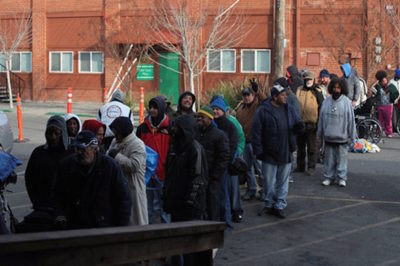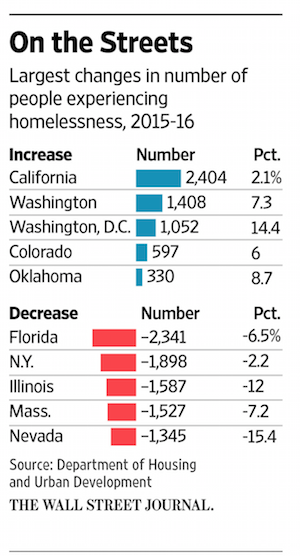Homeless Population in U.S. Drops Overall, but Rises in California
 ICCNC: Homelessness in the U.S. declined in 2016 by nearly 3% from the previous year, new federal data shows, though some states, including California, Washington, Colorado, and Oklahoma, as well as the District of Columbia, bucked that trend with notable increases.
The nationwide homeless population was 549,928, compared with 564,708 in 2015, according to the U.S. Department of Housing and Urban Development’s annual report to Congress, which was publicly released Thursday. The annual report tracks the number of people sleeping in shelters and streets across the U.S. on one given night each year.
ICCNC: Homelessness in the U.S. declined in 2016 by nearly 3% from the previous year, new federal data shows, though some states, including California, Washington, Colorado, and Oklahoma, as well as the District of Columbia, bucked that trend with notable increases.
The nationwide homeless population was 549,928, compared with 564,708 in 2015, according to the U.S. Department of Housing and Urban Development’s annual report to Congress, which was publicly released Thursday. The annual report tracks the number of people sleeping in shelters and streets across the U.S. on one given night each year.
Over the course of the Obama administration, which has targeted veteran and chronic homelessness, the homeless population has decreased by about 80,300 people or roughly 13%.
Despite the overall decrease in the number of homeless, more people are living on the streets, the report said.
The number of people living outdoors in encampments, on sidewalks, in parks or in cars increased by 1.8% between 2015 and 2016. The numbers are particularly acute in California, where two-thirds of the homeless population isn't sheltered.

California had the nation’s largest homeless population, with 118,142 people, the report said, a 2.1% increase since 2015. Of those, more than 78,000 people were living outdoors, with the rest in emergency shelters, transitional housing programs or other such locations.
RELATED COVERAGE
Washington state posted a 7.3% increase over the same period, Colorado had a 6% increase, Oklahoma had an 8.7% increase and Washington, D.C., had a 14.4% increase.
Many of the increases in the number of homeless have been in cities where high housing costs have played a role, such as Washington, D.C., Los Angeles, and Seattle, the department said.
“There is no doubt the lack of affordable housing is the big driver in our homelessness numbers,” said Norm Suchar, director of HUD’s Office of Special Needs Assistance Programs.
The increases in outdoor homelessness underscore the challenges West Coast cities face as higher rents and home prices have put a squeeze on the poor. Street encampments and public-safety fears surrounding homeless people have become top political issues in urban centers up and down the West Coast. Some jurisdictions have passed ordinances aimed at cracking down on the homeless, while others are asking taxpayers for more funds to address what many officials have called a crisis.
Earlier this year, the California state legislature passed a $2 billion plan to boost spending on homeless and affordable housing programs. In November, Los Angeles voters approved a $1.2 billion bond measure to combat homelessness in the city. But in San Francisco, voters approved a ban on homeless encampments, while rejecting a sales tax that would have increased funds for transportation and housing for the homeless.
Write to Alejandro Lazo at alejandro.lazo@wsj.com

